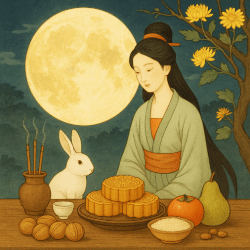Introduction: The Tao Is Closer Than You Think
You don’t need to shave your head or move to a monastery to practice Taoism. In fact, for most of us, the Way begins right where we already are—in the kitchen, in the garden, during a quiet morning moment. Taoist living, especially for lay followers, isn’t about withdrawal from the world. It’s about leaning into it with grace, rhythm, and a little ritual.
This guide collects the gentle, everyday practices of lay Taoists—what I like to call “sacred ordinary” moments. These are the kinds of rituals anyone can do, even if you’ve never studied a Taoist classic or stepped foot in a temple. If you’ve ever lit incense, tended a garden, or paused in awe at a sunrise… you’ve already begun.
1. Creating Sacred Space at Home
Every journey begins with a place to start from—and for many lay Taoists, that place is home. Your home becomes your temple the moment you treat it that way.
Personal Altars in Taoism: Learn how to create a quiet altar using simple symbols like dragons, stones, or incense holders. It’s less about perfection, more about presence.
Why Burning Incense Matters in Taoism: Lighting incense isn’t just fragrance—it’s intention made visible. The smoke rises like a prayer.
Mystical Taoist Tapestries: These symbolic cloths aren’t just pretty—they carry deep meanings that help focus your energy.
Sacred Gourds for Lay Practice: Gourds are ancient symbols of healing and wholeness. Placing one on your altar connects you to generations of seekers.
- Taoist Gardens: See how to build a garden to restore and focus your spirit to recover from the demands of daily life.
2. Honoring Time: Taoist Holy Days and Rhythms
Taoist time flows differently. It’s based on seasonal change and celestial cycles, not on fixed routines. When you honor Taoist holy days, you’re syncing up with the rhythm of the universe.
Taoist Holy Days: From Laozi’s Birthday to the Winter Solstice, these moments aren’t just commemorations—they’re invitations to pause, reflect, and re-align.
Taoist Sabbath: There’s no set day off. Instead, Taoists embrace a kind of sacred pacing. When you need rest, the Tao gives it—if you’re willing to listen.
3. Celebrating the Seasons: Everyday Festivals
One of my favorite things about Taoist living is how much joy and color it brings to each season. You don’t need a crowd or a temple—just a little intention and maybe a candle or peach.
Lunar New Year 2025 Guide: Celebrate the Wood Snake with food, fire, and fresh beginnings.
Taoist Summer Festival at Home: Invite the spirit of midsummer into your home with simple offerings and color themes.
Taoist-Inspired Thanksgiving: Gratitude is a practice, not just a feeling. Here’s how Taoists embrace the harvest season.
Peaches of Immortality Today: Explore the myth and magic of this fruit of eternal life—and how it might sweeten your own path.
4. Finding Sacredness in Nature
Taoist temples aren’t just buildings. They’re mountains, rivers, forests, and even street corners—if you’re paying attention.
Sacred Sites in the Everyday World: Maybe your sacred mountain is the neighborhood hill. Maybe your stream is the kitchen sink. Learn to see the sacred around you.
How Taoists Put Chimes at Sacred Sites: Hanging a wind chime isn’t just decoration—it’s devotion in motion.
5. Cleansing Body and Spirit
Even the everyday needs spiritual hygiene. Think of it as a gentle energetic rinse—something that resets you, like a good shower or a silent walk.
Taoist Biguan: This ancient retreat practice doesn’t have to mean going off-grid. It can start with a quiet weekend, a light diet, and a journal.
Taoist Bathing: Herbs, warm water, and mindfulness—yes, that’s spiritual too.
6. Taoism in Daily Life: Wine, Balance, and Joy
Taoism doesn’t ask you to renounce the world—it asks you to move through it with awareness and grace.
Do Taoists Drink Alcohol?: The answer is yes… and no. It’s all about balance, story, and what the moment calls for.
Taoism For a Better Life: A conversation with Taoist Master Mikel Steenrod on how everyday choices lead to deeper harmony.
7. Where to Begin: Taoist Foundations
If you’re just starting or want to go deeper, here are the “first pages” of your lay Taoist book:
What Is Taoism?: The big picture—simple, poetic, powerful.
Taoist Holy Days: Your spiritual calendar.
Personal Altars: Your spiritual home base.
Closing: It’s All Right Here
You don’t need a robe or a ritual to start walking the Tao. Sometimes all it takes is lighting a stick of incense, setting a bowl of fruit on your table, or watching the wind move through a tree.
Taoist living isn’t about changing your life—it’s about seeing it differently. The sacred is already here.
And so is the Way.
Frequently Asked Questions
Do I need to be initiated to practice Taoist rituals?
No. Taoist living for laypeople is about intention, not initiation. You can light incense, observe sacred days, and build an altar without formal training.
What is a Taoist lay practitioner?
A lay practitioner is someone who follows Taoist principles and rituals without being part of a monastery or priesthood. Most Taoists throughout history have been laypeople.
Can I celebrate Taoist festivals at home?
Yes! Taoist seasonal festivals like Lunar New Year, summer solstice, or autumn offerings can be celebrated with simple home rituals and seasonal decor.
Is incense required for Taoist practice?
While not required, incense is a common and powerful ritual tool. It symbolizes transformation and creates a sensory connection to the sacred.



